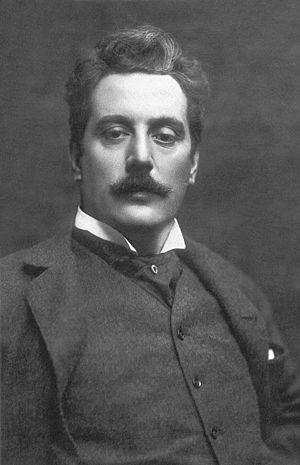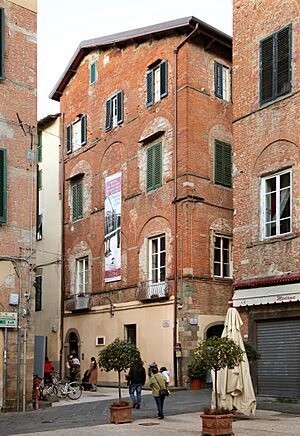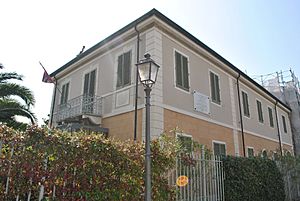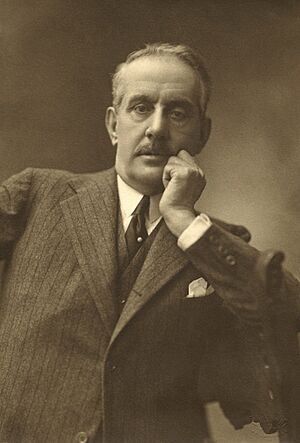Giacomo Puccini facts for kids
Giacomo Puccini (born December 22, 1858 – died November 29, 1924) was a famous Italian composer. He is best known for his many operas. Many people consider him the most important Italian opera composer after Giuseppe Verdi.
Puccini came from a family of musicians that had been composing for a long time. His early music followed the traditional style of Italian opera from the late 1800s. Later, he started writing in a more realistic style called verismo. He became one of the main composers of this style.
His most famous operas are La bohème (1896), Tosca (1900), Madama Butterfly (1904), and Turandot (1924). These operas are still performed and recorded very often around the world.
Contents
Early Life and School
Giacomo Puccini was born in Lucca, Italy, in 1858. He was the sixth of nine children. His family had been important musicians in Lucca for over 100 years. His great-great-grandfather, also named Giacomo, was the music director at the Lucca Cathedral. This job was passed down through the family.
When Puccini's father, Michele, died in 1864, Giacomo was only six years old. He was too young to take over the family job. However, he still took part in the church's music. He sang in the boys' choir and later played the organ.
Puccini went to school at a seminary in Lucca. His uncle, Fortunato Magi, helped him with his music lessons. In 1880, Puccini graduated from the Pacini School of Music in Lucca. He then received money from Queen Margherita and another uncle to study at the Milan Conservatory. He studied there for three years and even shared a room with another famous composer, Pietro Mascagni. At age 21, Puccini wrote a Mass for the church. This showed the end of his family's long history with church music.
First Operas
Puccini wrote an orchestral piece called Capriccio sinfonico for his final project at the Milan Conservatory. His teachers were very impressed. The piece was performed in 1883 and received good reviews. This helped Puccini start to become known in Milan.
Le Villi
After his school project, Puccini's teacher suggested he write an opera. Puccini worked with a writer named Ferdinando Fontana on an opera called Le Villi. He entered it into a competition, but it did not win.
However, Le Villi was performed in Milan in 1884. A music publisher, G. Ricordi & Co., helped by printing the words for the opera. Many of Puccini's fellow students played in the orchestra. The performance was a success, and Ricordi bought the opera. Puccini revised it, and it was performed again in 1885.
Edgar
The head of Ricordi, Giulio Ricordi, was so impressed with Le Villi that he asked Puccini to write another opera. This opera was called Edgar. Puccini started working on it in 1884.
Edgar was first performed in 1889, but it was not very popular. Ricordi defended Puccini, saying the problem was with the story, not the music. Puccini revised the opera several times over the years. However, Edgar never became popular.
Manon Lescaut
For his next opera, Manon Lescaut, Puccini wanted to write the story himself. But Ricordi convinced him to work with other writers. Four different writers worked on the story because Puccini kept changing his mind. Finally, Luigi Illica and Giuseppe Giacosa finished it.
Manon Lescaut premiered in Turin in 1893. It was a huge success! This opera made Puccini famous. People saw him as the most promising new composer of his time. He was even called the likely "successor" to Verdi. Illica and Giacosa then worked with Puccini on his next three very successful operas: La bohème, Tosca, and Madama Butterfly.
Middle Career
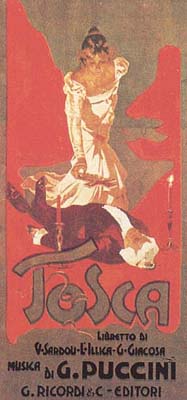
La bohème
Puccini's next opera was La bohème, which came out in 1896. It is based on a book about young, poor artists in Paris. The opera was first performed in Turin and was conducted by Arturo Toscanini. Soon, it was performed in many major opera houses around the world. It became, and still is, one of the most popular operas ever written.
The story of La bohème mixes funny moments of the poor artists' lives with sad parts, like the death of the young seamstress Mimí. Puccini himself was very poor when he was a student in Milan. He often had to sell his things to pay for food and rent. He once said, "I lived that Bohème, when I wasn't yet thinking of finding a story for an opera."
Another composer, Ruggiero Leoncavallo, was also writing an opera based on the same book. There was a public disagreement between them. Puccini said he started his work without knowing about Leoncavallo's project. He wrote: "Let him compose. I will compose. The audience will decide." Puccini's opera came out a year earlier and became a huge hit, while Leoncavallo's version was quickly forgotten.
Tosca
Puccini's opera Tosca premiered in 1900. This opera was his first step into the verismo style, which shows real-life situations, including violence. Puccini had wanted to make an opera from the play Tosca since 1889. He told his publisher that it was "the opera I need, with no overblown proportions."
The music in Tosca uses special musical themes for different characters and feelings. Some people thought Puccini was using a new style influenced by Richard Wagner. But others disagreed, saying it was purely Puccini's own style.
Car Accident
On February 25, 1903, Puccini was seriously hurt in a car accident. He was traveling at night with his future wife, Elvira, and their son, Antonio. The car went off the road and flipped over. Puccini was trapped under the car and broke his right leg. He also found out he had diabetes during his recovery. This accident and his long recovery slowed down his work on his next opera, Madama Butterfly.
Madama Butterfly
The first version of Madama Butterfly was performed in 1904. It was not well-received, partly because there weren't enough rehearsals. Puccini quickly took the opera out of production and revised it.
He made several changes, and a new version was performed a few months later in Brescia, Italy. This version was much more successful. Puccini made his final changes to the opera in 1907. This "standard version" is the one most often performed today.
Later Works

After 1904, Puccini wrote music less often. His main writer, Giacosa, died in 1906. Then, in 1912, his publisher, Giulio Ricordi, also passed away. This marked the end of a very busy period in Puccini's career.
La fanciulla del West
Puccini finished La fanciulla del West in 1910. This opera was asked for by the Metropolitan Opera in New York. It was first performed there on December 10, 1910. Famous singers Enrico Caruso and Emmy Destinn starred in it, and Toscanini conducted. This was the first time a world premiere of an opera happened at the Met.
The premiere was a great success. Some people criticized the opera for not having many stand-alone songs (arias). Others felt it didn't sound "American" enough. However, it is praised for its advanced music and complex rhythms. One song from the opera, Ch'ella mi creda, became very popular. It is said that Italian soldiers sang this song during World War I to keep their spirits up.
La rondine
Puccini finished La rondine in 1916. It was first performed in Monte Carlo in 1917. The opera was originally planned for Vienna, but World War I prevented it. Puccini's usual publisher, Ricordi, turned down the opera. So, a rival publisher arranged the first performance. Puccini continued to revise this opera, which is the least known of his mature works, until his death.
La rondine was first thought of as an operetta, which usually has spoken parts. But Puccini removed the spoken dialogue, making it more like a traditional opera.
Il trittico: Il tabarro, Suor Angelica, and Gianni Schicchi
In 1918, Il trittico premiered in New York. This work is made up of three short, one-act operas. Each one deals with a hidden death:
- Il tabarro is a dark and scary story.
- Suor Angelica is a sad and emotional tragedy.
- Gianni Schicchi is a funny comedy.
Turandot
Turandot was Puccini's last opera. He died before he could finish it in November 1924. The last two scenes were completed by another composer, Franco Alfano, using Puccini's notes. The story of Turandot is based on an old play. The music has many Asian-sounding melodies. Turandot includes one of the most famous opera songs, Nessun dorma.
Working with Writers
The story for Puccini's opera Edgar was a big reason it failed. After that, Puccini was very careful about choosing stories for his new operas. He was also very involved in writing the stories himself. He often asked for many changes to the words and structure. This sometimes made his relationships with the writers very difficult. His publisher, Casa Ricordi, often had to help them settle their disagreements.
Puccini thought about many different stories for operas but ended up not using them. Some of these abandoned ideas were later turned into operas by other composers.
Life at Torre del Lago
From 1891 onwards, Puccini spent most of his time at Torre del Lago. This was a small town near Lucca, located between the sea and a lake. Puccini loved hunting there. He once said, "I love hunting, I love cars: and for these things, in the quiet of Torre del Lago, I keep my faith."
By 1900, he bought land and built a house on the lake, which is now called the "Villa Puccini". He lived there until 1921. He had to move because pollution from nearby factories made the lake dirty. After he died, a special tomb was made in the Villa Puccini, and he is buried there with his wife and son.
The Villa Puccini is now a museum and is open to the public. Every year, a Festival Puccini is held in Torre del Lago to celebrate his music.
Puccini and Politics
Unlike some other famous composers like Wagner and Verdi, Puccini was not very involved in politics. One of his biographers said that he seemed almost uninterested in politics throughout his life.
Puccini's lack of interest in politics caused some problems during World War I. His close friendship with conductor Toscanini was interrupted for almost ten years. This happened because Puccini said that Italy could learn from Germany's organization, even though Italy and Germany were on opposite sides in the war. Puccini also faced criticism for working on La rondine with an Austrian theater company during the war. He did not join public war efforts, but he did help individuals and families affected by the war in private.
In 1919, Puccini was asked to write music for a song honoring Italy's victories in World War I. This song, Inno a Roma (Hymn to Rome), was played at public events. Although it was not written for them, it was often played during Fascist parades and ceremonies later on.
Puccini had some contact with Benito Mussolini and the Italian Fascist Party in the year before he died. In 1923, the Fascist Party in Viareggio made him an honorary member. Puccini hoped to become a Senator, an honor given to people who made great cultural contributions, like Verdi. He also wanted to build a national theater in Viareggio, which needed government support. Puccini met with Mussolini twice to ask for help with the theater project. The theater was never built, but Puccini was named Senator a few months before his death.
Puccini died before Mussolini took full control of the Italian government in 1925.
Death
Puccini smoked a lot of cigars and cigarettes. Towards the end of 1923, he started having chronic sore throats. Doctors found he had throat cancer. They suggested a new type of treatment in Brussels. Puccini and his wife did not know how serious the cancer was; only his son was told.
Puccini died in Brussels on November 29, 1924, at age 65. He passed away from problems after the treatment, including bleeding that led to a heart attack. When news of his death reached Rome during a performance of La bohème, the opera was stopped. The orchestra then played Chopin's Funeral March for the sad audience.
Puccini was first buried in Milan. But in 1926, his son arranged for his father's body to be moved to a special chapel inside the Puccini villa at Torre del Lago.
Puccini Studies
The Centro di studi Giacomo Puccini was started in 1996 in Lucca. It studies Puccini's work in many different ways. In the United States, the American Center for Puccini Studies focuses on performing his less common works and introducing unknown pieces. It was founded in 2004 by Harry Dunstan.
Works
Puccini wrote orchestral pieces, church music, chamber music, and songs. His most notable non-opera works include his 1880 Messa di gloria (Mass) and his 1890 string quartet piece Crisantemi. However, he is mostly known for his operas:
- Le Villi, first performed May 31, 1884
- Edgar, first performed April 21, 1889
- Manon Lescaut, first performed February 1, 1893
- La bohème, first performed February 1, 1896
- Tosca, first performed January 14, 1900
- Madama Butterfly, first performed February 17, 1904
- La fanciulla del West, first performed December 10, 1910
- La rondine, first performed March 27, 1917
- Il trittico (three one-act operas), first performed December 14, 1918
- Il tabarro
- Suor Angelica
- Gianni Schicchi
- Turandot, first performed April 25, 1926 (finished by Franco Alfano after Puccini's death)
Images for kids
See also
 In Spanish: Giacomo Puccini para niños
In Spanish: Giacomo Puccini para niños


